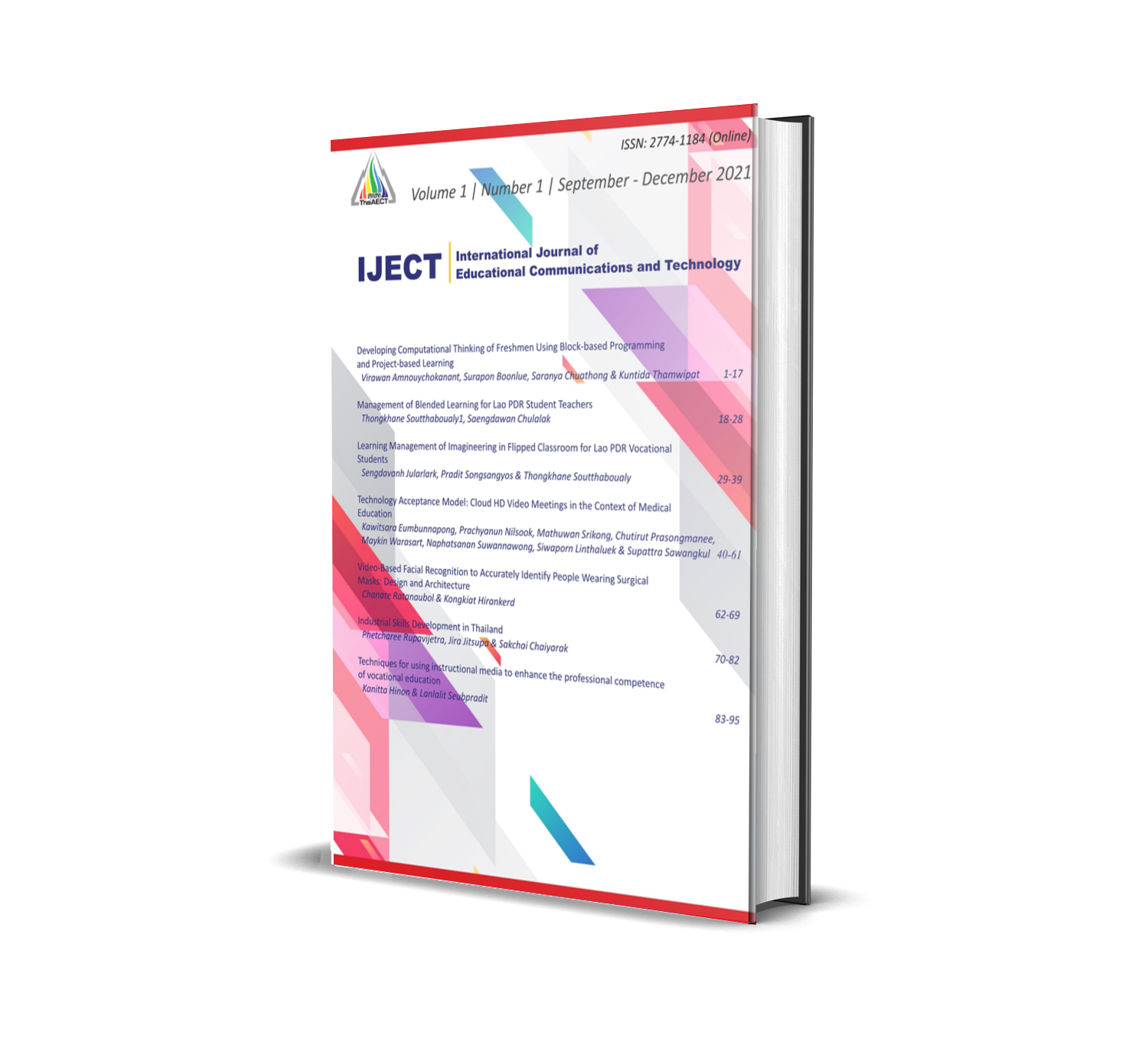Information and Communications Technology Intelligence Risk Assessment for Digital Universities
Keywords:
Risk assessment, Data Intelligent, Digital UniversityAbstract
This document Currently, the technological advance has an important part in developing the university in entering to the digital organization for helping to develop the organization to have the progress and will help to increase the efficiency in the management in every side rapidly via the technology which will have the accuracy and the precision. However, this will have the risk which may give the effect to let the organization create the damage. This will be needed to have to evaluate the technological risk for the organization to plan to cope with the effect that may be happening in the future. The risk management by the intelligent information technology, this is found that from evaluating of the risk with the intelligent information in the information technology for the digital university, this has components which have risk factors that are happened in the university which have both internal factors, external factors, the analysis of the data intelligent for evaluating the risk in the digital university. This has the information and the technology that are important parts in driving for evaluating other risk levels that are happened within the organization from the large database with the in-depth analysis for examining the error and showing the guideline for making the decision in order to create the least effect on the personnel, the student, the stakeholder and the community for bringing to the creation of the digital organization for the education effectively and having the safety sustainably.
References
Abaoud, D. (2020). The relationship between knowledge management practices and enterprise risk management in
higher education: An action research. 27th European Conference on Information Systems – Information
Systems for a Sharing Society, ECIS 2019, 0–15.
Anyim, W. O. (2020). Internal Control and Risk Management System in University Libraries:
Applications, Techniques and Limitations. Library Philosophy and Practice, 2020(October), 1–21.
Ateş, V., & Güneş, B. (2018). The factors affecting information technologies risk management at
Turkey’s state universities. International Journal of EBusiness and EGovernment Studies, 10(2), 46–62.
Beecher, B., & Streitwieser, B. (2019). A Risk Management Approach for theInternationalization
of Higher Education. Journal of the Knowledge Economy, 10(4), 1404–1426. https://doi.org/10.1007/s13132-017-0468-y
Berdykulova, G., Ipalakova, M., Kamysbayev, M., & Daineko, Y. (2020). Towards digital
university: Experience of kazakhstan. ACM International Conference Proceeding Series. https://doi.org/10.1145/3410352.3410793
Bilyalova, A., Salimova, D., & Zelenina, T. (2020). Higher Education in Digital Age. Advances
in Intelligent Systems and Computing, 1114 AISC, 207–219. https://doi.org/10.1007/978-
-030-37737-3_19
Channgam, S., Nilsook, P., & Wannapiroon, P. (2019). Intelligent information management with
digitization workflow. International Journal of Machine Learning and Computing, 9(6),
–892. https://doi.org/10.18178/ijmlc.2019.9.6.888
Dash Wu, D. (2020). Data intelligence and risk analytics. Industrial Management and Data
Systems, 120(2), 249–252. https://doi.org/10.1108/IMDS-02-2020-606
Dehdashti, A., Fatemi, F., Janati, M., Asadi, F., & Kangarloo, M. B. (2020). Data of risk analysis
management in university campuses. BMC Research Notes, 13(1), https://doi.org/10.1186/s13104-020-05397-4
Denzler, A., & Kaufmann, M. (2017). Toward granular knowledge analytics for data intelligence:
Extracting granular entity-relationship graphs for knowledge profiling. Proceedings - 2017 IEEE International Conference on Big Data, Big Data 2017, 2018-Janua, 923–928. https://doi.org/10.1109/BigData.2017.8258010
Khalil, N., Kamaruzzaman, S. N., & Baharum, M. R. (2016). Analytical Hierarchy Process for
Developing a Building Performance-Risk Rating Tool. MATEC Web of Conferences, 66. https://doi.org/10.1051/matecconf/20166600123
Kim, D., Yun, J. J., & Hagen, L. (2020). DG . O 2020 : Governance in the Era of Data
Intelligence. 524–526.
Kozlova, A., & Snegurenko, A. (2019). University risk assessment and management system. IOP
Conference Series: Materials Science and Engineering, 666(1). https://doi.org/10.1088/1757-899X/666/1/012050
Lezer, V. A., Shabatura, L. N., & Karnaukhov, I. A. (2020). The Flagship University’s Model in
Terms of Digitalization: The Case of Industrial University of Tyumen as a Center of Strategic Decisions in the Field of Smart-City, IoT/IIoT and Big Data. Lecture Notes in Networks and Systems, 91, 387–396. https://doi.org/10.1007/978-3-030-32015-7_43
McDonald, T. J., O’Byrne, D., O’Leary, P., & O’Riordan, C. (2020). Development of an
academic risk model to support higher education quality assurance. International Conference on Higher Education Advances, 2020-June, 1323–1329. https://doi.org/10.4995/HEAd20.2020.11261
Orozova, D., Kaloyanova, K., & Todorova, M. (2019). Introducing information security concepts
and standards in higher education. TEM Journal, 8(3), 1017–1024. https://doi.org/10.18421/TEM83-46
Perez Gama, J. A., Vega Vega, A., & Neira Aponte, M. (2018). University digital transformation
intelligent architecture: A dual model, methods and applications. Proceedings of the LACCEI International Multi-Conference for Engineering, Education and Technology, 2018-July(July), 19–21. https://doi.org/10.18687/LACCEI2018.1.1.274
Popova, T. N., Mitrofanova, Y. S., Ivanova, O. A., & Vereshchak, S. B. (2020). Economic and
Organizational Aspects of University Digital Transformation. Smart Innovation, Systems and Technologies, 188, 371–381. https://doi.org/10.1007/978-981-15-5584-8_32
Rozhkova, D., Rozhkova, N., & Blinova, U. (2020). Digital Universities in Russia: Prospects and
Problems. Advances in Intelligent Systems and Computing, 1114 AISC, 252–262. https://doi.org/10.1007/978-3-030-37737-3_23
Safhi, H. M., Frikh, B., Hirchoua, B., Ouhbi, B., & Khalil, I. (2017). Data intelligence in the
context of big data: A survey. Journal of Mobile Multimedia, 13(1–2), 1–27.
Secundo, G., Rippa, P., & Cerchione, R. (2020). Digital Academic Entrepreneurship: A
structured literature review and avenue for a research agenda. Technological Forecasting and Social Change, 157(May), 120118. https://doi.org/10.1016/j.techfore.2020.120118
Shikhnabieva, T. (2020). Knowledge-Based Model Representation for a Modern Digital
University. Smart Innovation, Systems and Technologies, 188, 55–65. https://doi.org/10.1007/978-981-15-5584-8_5
Singh, U. K., & Joshi, C. (2017). Information security risk management framework for
University computing environment. International Journal of Network Security, 19(5), 742–751. https://doi.org/10.6633/IJNS.201709.19(5).12
Suroso, J. S., & Fakhrozi, M. A. (2018). Assessment of Information System Risk Management
with Octave Allegro at Education Institution. Procedia Computer Science, 135, 202–213. https://doi.org/10.1016/j.procs.2018.08.167
Zhang, X., & Yang, D. (2019). The development of image creation method by data intelligence-
based automated pastiche. Proceedings of 2019 IEEE 2nd International Conference on Automation, Electronics and Electrical Engineering, AUTEEE 2019, 129–135. https://doi.org/10.1109/AUTEEE48671.2019.9033430
Downloads
Published
How to Cite
Issue
Section
License

This work is licensed under a Creative Commons Attribution-NonCommercial-NoDerivatives 4.0 International License.







